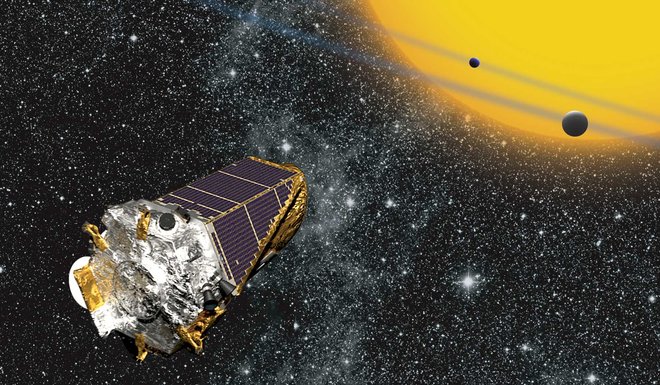That was intriguing enough for them to be awarded a chunk of coveted observing time on the Hubble Space Telescope, to take a closer look.
這對他們來說足夠令人著迷,因為他們可以獲得大量觀測時間,用哈勃空間望遠鏡進行更近距離的觀測。
The Hubble has a much bigger mirror than Kepler, and so should be able to generate a firmer signal.
哈勃的鏡面比開普勒大得多,因此應該能夠產生一種更強的信號。
After 40 hours of observation, and after putting their data through the statistical wringer to try to remove any possible sources of bias,
進行了40個小時的觀察后,并在進行了大量的數據篩選排除了任何可能的偏見后,
such a signal is exactly what they think they have found.
這樣一種信號正是他們認為他們所發現的。
Only big moons would cause enough of a dip in brightness to be detectable with today's instruments.
只有大衛星才會造成足夠的光亮傾角,從而被現在的儀器探測到。
And, with the important caveat that the room for uncertainty is large, Kepler-1625b's proposed moon seems indeed to be a real whopper.
有了這個重要的警示—不確定的空間非常巨大,Kepler-1625b的擬議衛星似乎確實是真實存在的巨物。
Dr Kipping thinks it is at least as massive as Earth itself. Its diameter seems to be about four times greater, roughly that of Neptune.
基平博士認為其至少和地球一樣巨大。其直徑似乎約有海王星的四倍之大。
Its parent planet is comparably hefty—more massive even than Jupiter, the solar system's biggest world.
其母行星相對更大—甚至比木星還大,木星是太陽系中體積最大的。

Intriguingly, there are hints that the newly found moon's orbital plane may be tilted with respect to its parent planet's orbit around the system's star.
有趣的是,有暗示表明,關于其環繞星系恒星的周圍的母行星軌道,這顆新發現的衛星的軌道平面或許是傾斜的。
The only moon in Earth's solar system with a similar arrangement is Triton, a satellite of Neptune.
地球太陽系中唯一一個有類似情況的衛星是海衛一,一顆環繞海王星運行的衛星。
Rather than forming in place, Triton is thought to have been captured by Neptune from the Kuiper Belt, a sort of cosmic junkyard beyond Neptune's orbit.
海衛一的形成地并不在這里,普遍認為海衛一是被海王星從柯伊伯帶俘獲過來的,柯伊伯帶是在海王星軌道另一邊的宇宙垃圾場。
And it is just possible that things are stranger still. The moon's parent star is elderly, and is in the process of swelling into a red giant.
事情可能還是很奇怪。這個衛星的母恒星年歲較大,并且還在向紅巨星膨脹的過程中。
Dr Kipping speculates that one explanation for the moon's giant size might be that the dying star is heating the moon's atmosphere,
基平博士推測衛星巨大體積的解釋之一或是因為這個枯萎的恒星加熱了衛星的大氣,
causing it to expand and increasing the moon's effective diameter.
導致其擴張并使衛星的有效直徑增長。
Assuming, that is, that the moon is real at all. To nail this question down, Dr Teachey and Dr Kipping hope to be granted more time on the Hubble next May,
假設這顆衛星真實存在。為了得到確定答案,提奇和基平博士希望明年五月能有更多時間利用哈勃空間望遠鏡進行觀測,
when—if their previous observations were correct— the planet and its putative moon are next due to swing in front of their star.
那時—如果他們之前的觀察沒錯的話—行星及其假定衛星就是下一個在恒星前邊晃動的物體。
Separately, they are hoping to use the Keck telescope, in Hawaii, to try to measure the wobble that the moon's parent planet induces in its star.
他們希望在夏威夷使用凱克望遠鏡測量該衛星的母星在其恒星中引發的搖晃度。
譯文由可可原創,僅供學習交流使用,未經許可請勿轉載。












